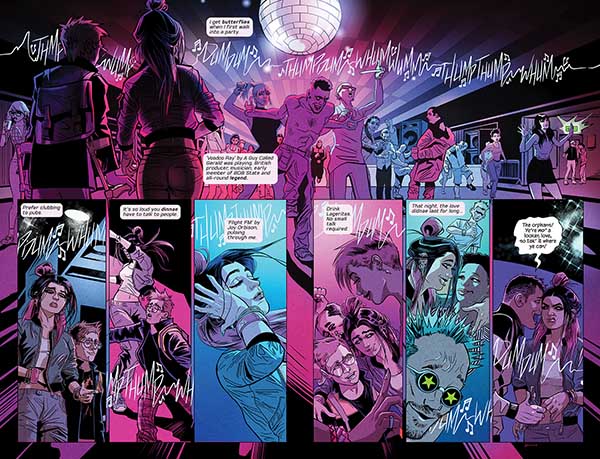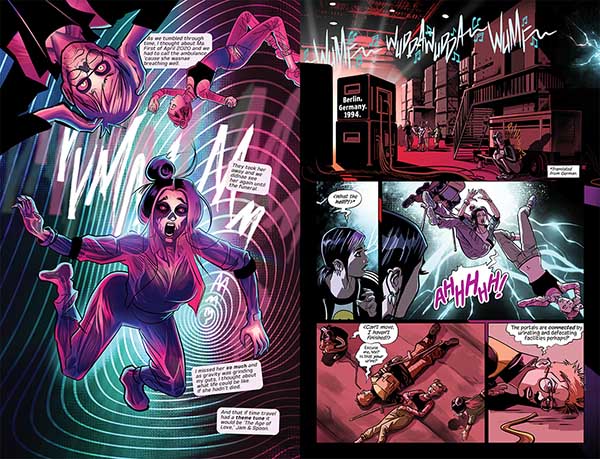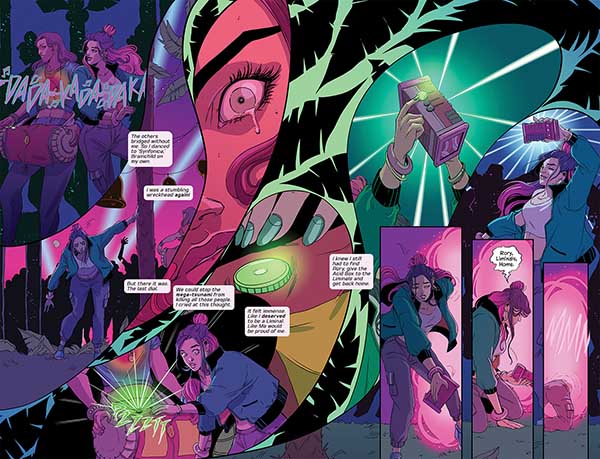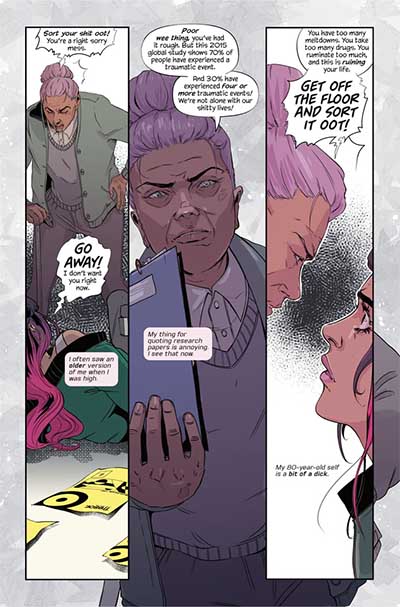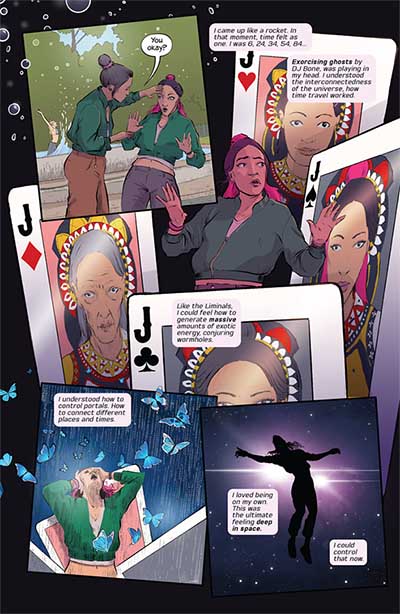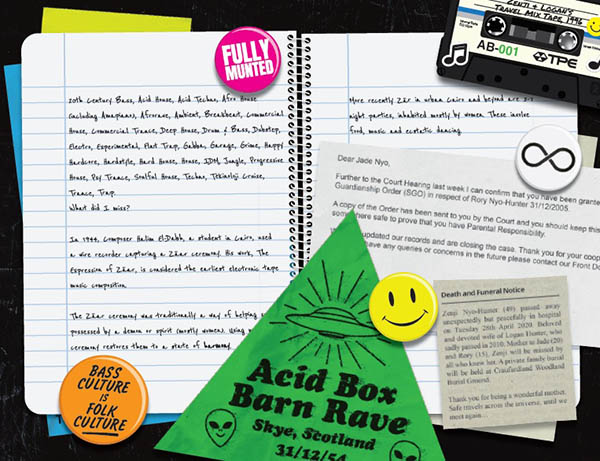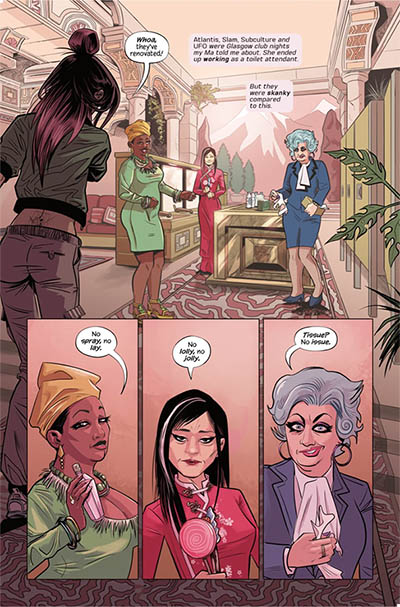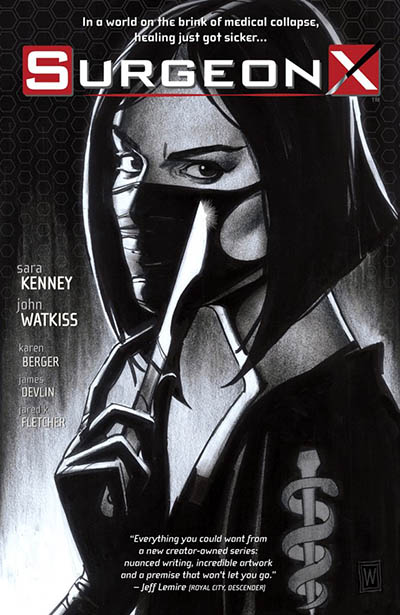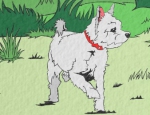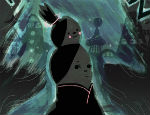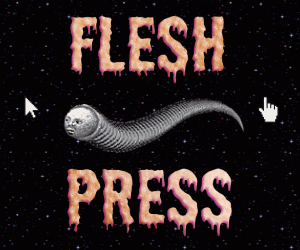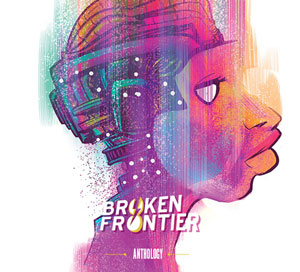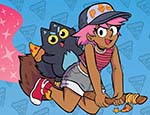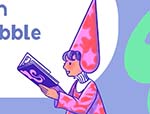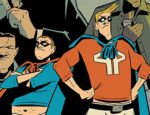Described as “a darkly comic adventure through club culture, spanning space and time”, Acid Box is a multi-creator graphic novel with a difference, currently crowdfunding on Kickstarter. Written by Sara Kenney with a whole host of collaborators including artists James Devlin, Emma Vieceli and Ria Grix, colourist Sofie Dodgson, letterer Hassan Otsmane-Elhaou, and designer Joe Stone. It’s a project that expands far beyond its narrative with Kenney’s Wowbagger Productions also using it as an opportunity for mentorship for young creators. And it’s published by Avery Hill which will come as little surprise to anyone given the book’s eclectic and wildly imaginative nature. We caught up with Kenney (and some of the team!) to talk about Acid Box‘s themes, ’90s club culture and providing opportunities for young people…
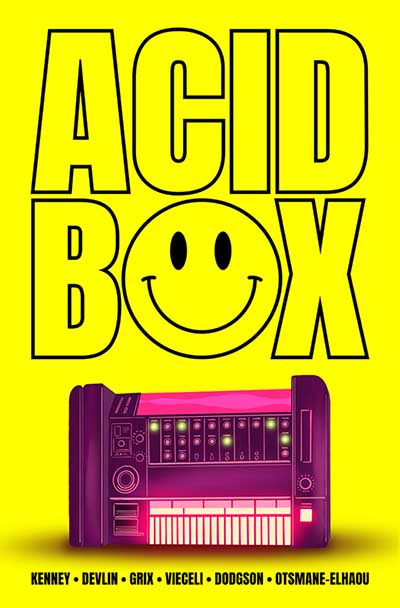
ANDY OLIVER: Before we talk about Acid Box can you tell us first about the origins of Wowbagger Productions, its ethos and aims, and your cross-media approach to storytelling?
SARA KENNEY: Hey Andy thanks for inviting me to be interviewed. I started out working in science at the Environment Agency in 1998 and left to work in TV in 2000. I set up Wowbagger in 2011, off the back of working for Wellcome for a year as their Broadcast Manager (covering the postholder’s maternity leave). I’d never heard of them at this point, but saw that they funded projects like The Great Sperm Race and Here’s Johnny a documentary about the incredible 2000 AD artist the late Johnny Hicklenton and his battle with MS. Wellcome clearly did cool and innovative stuff.
I was inspired by their interdisciplinary approach of bringing together artists, scientists and humanities experts. I’d become frustrated with the limitations of TV (who gets to tell the story, it was a lot less diverse in 2010). The ethos of Wowbagger is to create inventive stories (film, games, comics, events) told from unheard perspectives.
I’ve written for TV, games, print and events, so I guess that’s where the crossmedia comes from. I like experimenting with formats!
Art by James Devlin
AO: How did Acid Box come to Avery Hill Publishing? What made them such a good fit for this particular project?
KENNEY: I went to one of their exhibitions at Thought Bubble last year when they were showcasing the art of Sue Bird and Tim Bird. I feel like they are a refined publisher so didn’t initially think they’d go for our rag tag band, but Lucy Sullivan spurred me on to pitch to them! I think Acid Box is a good fit, because we’ve got some amazing creators on-board and a great roster of newbies and pros. It’s not a perfect comic, but we’ve got some gorgeous art in there and it all came together like a messy mix tape! I’ve never met Ricky Miller who runs Avery Hill, but he liked the project and has expertly guided us as we’ve finished the book. So perhaps Ricky’s words are more helpful here:
RICKY MILLER: When Sara contacted me about Avery Hill getting involved in putting out this book, I was immediately attracted to the themes and subject matter. It’s a story about power, control, and nature, as well as dancing, recreational drugs and dance music in the ’90s! As someone who is from the ’90s I could identify with this, although I was too nerdy to go to raves; I was probably at home reading comics. This is a really enjoyable read for those who were there in the ’90s and even for those who weren’t there (and if you remember it then you probably weren’t there anyway, right?).”
KENNEY: Nb. I met a LOT of nerds at raves.

Sara Kenney, James Devlin, Emma Vieceli and Ria Grix
AO: Introduce the BF readership to the characters of Acid Box. Who are the cast and how would you summarise the book’s premise?
KENNEY: The book is a time travel story through rave culture, seen through the eyes of Jade Nyo who is a bit of a lost it. When Jade is given the powerful ACID BOX she faces a battle to control both herself and the world around her in order to prevent a global disaster.
In terms of the cast, I love a list so…
Jade Nyo (26) is British-Burmese and lives in Glasgow in 2026. She works as a cleaner in the magnificent Mitchell Library and supports her brother, Rory, since the death of their parents. Jade is confident about how she sees the world, but has lost faith in others and the world around her. She’s fun, smart, and a bit of a dickhead.
Rory Nyo (21) is Jade’s brother. He’s an old soul studying engineering at University of Glasgow. He collects rocks and has a fear of urine (urophobia). He’s kind and willing to please, which means people can take advantage.
Siya Pradeep (23) German/Indian, she’s a goth raver from 1994. Siya is introverted and struggles to make friends. But she will die for who and what she believes in and this can be both dangerous, yet advantageous for the team.
Art by James Devlin
Rhonda Rosenberg (26) African-American, with a heart of gold, from Detroit in 1994. Rhonda is loyal with a strong sense of justice. She works as a Detroit tour guide and also has a geological rock collection. She’s a smart, friendly, sober nerd with a love of history.
Fizzy Watson-Jones (24) is posh and bohemian, with no fixed address or time (originally from the 1990s). People assume she’s stupid, but she’s got more smarts than she or others realise.
The Liminals Yemaya, Tracey, and Angie are Liminals: older beings who hold the secret to time travel and the ACID BOX. Like the best Aunties, they are there to support and criticise in equal measure.
AO: How would you describe the themes of Acid Box? What were you looking to explore in terms of the musical movement that it’s grounded in and the ideas of friendship, connection and community that sit at the book’s core?
KENNEY: Themes are plentiful – climate change, power, neurodiversity, friendship, life transitions, anger, the use of drugs in culture, intergenerational dynamics, the impact of dance culture.
The rave scene emerged in the late ’80s from an era of oppression for many. Thatcher’s children, miners’ strikes, extreme capitalism, rise of consumerism, and individualistic culture. But when you were at a ‘free party’ you were surrounded by people from all walks of life. It felt like anything was possible; that we could and should push for change. Many of us have carried on with this ‘rave against the machine’ journey into our adult lives.
Art by Emma Vieceli
Contrary to what some of Hollywood might tell us, I think it’s hard to fight the monsters on your own. This is where friendship, connection and community are so important. Finally FUN! I feel like we’re losing the art of having fun. It’s important to have space to be a total idiot. The world feels so hostile and serious right now. There’s some fun to be had in them there hills (woods, warehouses, beaches, clubs etc.).
AO: With James Devlin, Emma Vieceli, Ria Grix and Alison Sampson you have quite the line-up of artistic talent on Acid Box, to varying degrees of involvement. The book had something of a tortuous journey to publication. Did the evolving line-up of artists prove to be somehow serendipitous in the end?
KENNEY: Yes for sure. Jimmy did an incredible job on chapter 1 & 2, really understood the storyworld and was the inspiration for Jade being Glaswegian of course! We were very lucky Emma Vieceli had a window to hop on for chapter 3. Her artwork is incredible and I loved the personality she brought to the characters. Emma is not and never has been in to dance culture though…
EMMA VIECELI: I’m not sure I want to admit to the world that I’m basically really uncool and was playing tabletop roleplay games and magic the gathering while the cool kids were out at clubs, but there we go. Warm beverages were my alcohol, crisps were my drugs. But, believe me, dice are addicting, and I’ll bet the high of winning a battle in Mechwarrior can’t have been far off the euphoria of a good tune pounding through your veins?’
KENNEY: This made me chuckle but again nb. there were lots of very uncool kids in the clubs!! J
Art by Emma Vieceli
Ria Grix as you know is a quiet soul within the world of comics and I met them through Sofie, so it worked out perfectly.
I’ll let Ria take over here:
RIA GRIX: I thought the cast were a great mix of characters and I tried to get a different look in their facial expressions to reflect it, like Siya with a bit of grit and Fizzy with, well… fizz! I remember the slow erosion of freedoms in the Criminal Justice Act of 1994 and remember people I knew going on marches to oppose it (I had previously marched against student loans and the Poll Tax) so when drawing the book it bought back a lot of memories of that period and I thought the script captured that time perfectly. I like creating characters from scratch so was happy to get a bit of time towards the end of the book to create a few new characters from scratch, and add a few cyberpunk (probably my fav genre) inspired costumes.
KENNEY: Alison did some gorgeous chapter headings for us for the young adult section of the book. Initially I thought we would have this as a separate comic or pull out at the end, but it’s all been combined.
Art by Ria Grix
AO: Sofie Dodgson is one of the finest colourists working in comics right now and I firmly believe Hassan Otsmane-Elhaou provides an absolute masterclass in the letterer’s craft on every comic he’s involved with. And, of course, with Joe Stone you have a Broken Frontier Six to Watch star applying his intuitive design skills to the mix. What special qualities did this distinguished trio bring to the book for you?
KENNEY: They brought all the epic skills and fun. Sofie and their colouring work are pure magic. I met them at Thought Bubble in 2021 and we’re both into electronic music, festivals and the free party scene. I think Sofie’s lived experience of hanging out at these sorts of parties from dusk ‘til dawn is really evident in the colours.
I’ve worked with Hass a few times now and you can’t underestimate the power of lettering. It’s a whole other texture beyond pictures, words, colour, isn’t it? Hass also really helped visualise the sounds of techno and drum & bass. I shared my dodgy SFX interpretations of a breakbeat or bassline with him and he managed to weave them across the page beautifully.
Handing over to Joe Stone in his own words:
JOE STONE: There is so much design iconography at the heart of rave culture; through the flyers, t-shirts, badges, and even the pills, and the narrative of Acid Box pays homage to so much of it. I wanted to translate some of that DIY-zine feeling from the 90s scene in particular to the design ethos for the book. The colour palette and the logo design in particular are directly inspired by logos and posters from iconic raves, but through adding additional texture and tactility to various pages I wanted to give the sense of the raves and venues the characters visit being these physical spaces from a pre-digital age.
In the diary pages especially I attempted to get across that sense of tactility, and show how physical objects can be so deeply tied to a particular time and place. They help give a bit of an insight into Jade’s head and show her respect for the past and share a bit of her creative side.
KENNEY: This distinguished trio are just magic.
Design by Joe Stone
AO: So obviously this is a music-oriented comic with a sci-fi twist. I go against the grain a little here because I actually think clever visuals in comics can really work to ensure the reader hears the music depicted without having to… well… hear the music. But you have provided a playlist as well. What can readers expect from that in terms of nostalgic accompaniment?
KENNEY: I love a playlist. Certain situations make me think of a track and certain tracks make me think of situations, characters, scenes and stories. In the comic Jade experiences the same thing, she’s falling through a wormhole and it reminds her of a tune she loves.
I think the nostalgia of bass, rave, free party, club culture whatever you want to call it have different impacts or associations depending on who you are. There are many misconceptions surrounding the culture often perpetuated by the media. That of a slightly ominous and scary space Or cheesy neon, fluffy bras with whistles and white gloves.
I want to point you to an article my good friend Joe Muggs (a brilliant music journalist) wrote about misconceptions, in which he writes “essentially, racism, homophobia, sexism and classism kept dance culture marginalised for a very long time indeed.” Read it here.
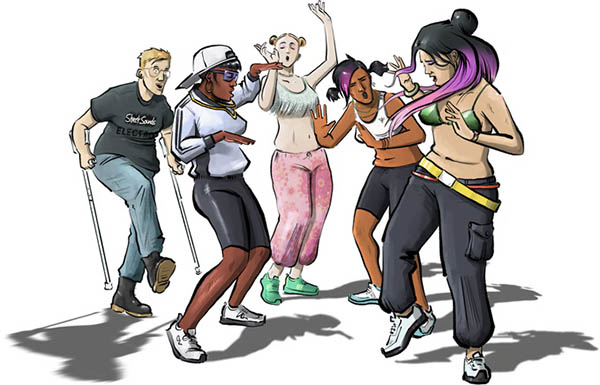
Art by Ria Grix
Even if you’re a die-hard rock fan, I’d love it if people check out the playlists…
Here’s ‘Jade’s tracklist’ from the comic on YouTube. and on Spotify.
Then I did a ‘Poptastic’ version for the Acid Box Soft Crew on YouTube and on Spotify.
And here’s one featuring ‘Extra Bangers’ (also great for running, walking or sitting to) on YouTube and on Spotify.
When my editor Katie West (who joined us a bit later in the project) was sending me notes on the script, they would often just write ‘TUNE!!!’ in the comments. They had some amazing rave stories too. We talk about ‘finding your people’ in the comic and I’ve come away with a few new friends at the end of this wild project.
AO: Broken Frontier is actively involved in mentoring newer voices in comics so one aspect of Acid Box that really stands out is both the involvement of, and opportunities for, young people that you created with the project, who got to creatively explore the elements and themes of the book. Could you expand on how you went about that in terms of facilitating and organising, and give readers an idea of how that fed into the finished printed graphic novel?
KENNEY: Absolute props to you guys for the work you do at Broken Frontier. I’ve been mentoring young people since I started Wowbagger back in 2011. I fund this work through grants, and this pays me to run workshops with young people. I’ve run 100s of workshops and mentoring sessions over the years. We pay the young people to attend the workshops (NIHR rates at £25 per hour) and then we pay them for creating a piece of artwork (expertly edited and project managed by Kirsten Murray). They also get a percentage cut of profits from the comic.
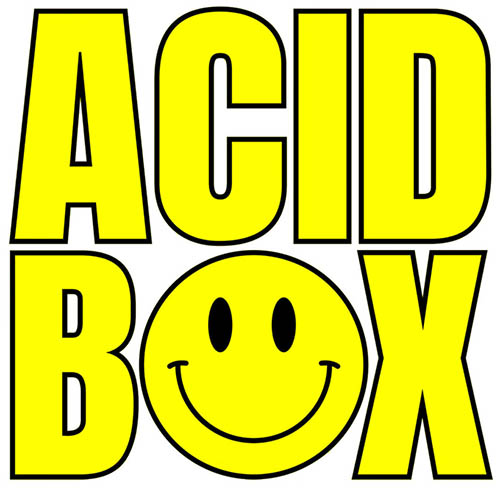
Design by Joe Stone
The idea is to bring artists, scientists and humanities experts together to discuss a subject. They look at things through a slightly different lenses so have different takes on things, and this makes the conversations much richer.
The young people spoke to Karen Berger (editor), Dr. Tana Joseph (astronomer, time travel), Professor David Nutt (neuropsychopharmacologist ), Gemmy (musician), Professor Divya Jindal-Snape (education/ life transition researcher), Karrie Fransman (artist), Joe Muggs (music journalist), Irvine Welsh (writer), Dr Suzi Gage (psychologist), Shelly Bond (editor), Rhiannon Griffiths MBE (comics youth), Lucy Sullivan (artist), Prof. Stephen Husbands (medicinal chemistry), Katy Porter (The Loop), Toya Delazy (inventor of ‘Afrorave’), Jeremy Deller (artist), and many more.
The young creatives then had to pick a conversation they loved and create a comic, write an article or a piece of music. These pieces are included in the back of the book. We also ran workshops about working in arts or sciences. We covered everything from portfolios to pensions and accounting to bid writing. What does it take to practically survive working as a creative?
I’m currently mentoring three from the cohort, I’ve worked with over the years (Sevitha Vadlamudi, Sarah Zad and Mairead Ruane) to work as producers and arts/science facilitators. They get freelance pay at the moment but would love them to get a wage and take over Wowbagger tbh!!
AO: What kinds of rewards beyond the book itself can backers expect from the Acid Box Kickstarter?
KENNEY: We worked with Avery Hill to research some environmentally friendly merch (although that’s probably an oxymoron isn’t it)? We’ve got some tote bags, designed by Joe Stone that are decent quality and will hold your comics. Some coasters with art by Alison Sampson and Ria Grix.
We’ve got some wonderful bookplates and hand drawn sketches by Ria Grix.
Art by James Devlin
AO: And, finally, what next from Wowbagger after Acid Box, either inside or outside comics?
KENNEY: Outside comics I’m currently working part-time for the Environment Agency as an ‘Innovation & Engagement Manager’. I’m interested in ‘working from the inside’ to try and shift systems and scale some of this community engagement work. I’m running a pilot project exploring how a ‘bottom up’ approach to engagement can build resilience for communities at risk of flooding. I’m working with community orgs to help them get funding to lead and create participatory art projects (using film, comics, games, events). It’s quite fun writing bids that aren’t for my org!
I’ve just written a 10-page comic for Kings College exploring community engagement. Hanna Gwynn is currently illustrating this (it’s gorgeous, we have tardigrades, octopus and bears) with brilliant editor Katie West working on this too.
I got a Developing Your Creative Practice (DYCP) Grant from Arts Council England, so working on something for that. Katie W is editing this with me too!
EXCLUSIVE for you Andy: My first comic Surgeon X (Image Comics) is now out of print and the multimedia elements (animations, documentaries and podcasts) are stored in drives. So we’re exploring how to get it all on-line (free to the audience) working with Michael Mensah-Bonsu who designed the original app version. We’ve just received a ‘Global Strategy Lab Seed Funding Grant’ from York University, Canada to help develop the idea.
We’re collaborating with Dr Alison Humphrey from GSL (who was a Marvel intern in her youth). We’re partnering with The Fleming Initiative, to work with patients and update some of the stories. I’m writing a few pages but generally getting out of the way. Mairead Ruane will be producing, Warren Pleece on art, Karen Berger back at the helm editing, Sofie Dodgson on colour and Richard Bruning back in the design seat. Looking forward to that!
Do check out Acid Box though – you get 200 pages, which is a lot of bangers for your buck…
Interview by Andy Oliver





